Abstract
Environmental exposures to benzene result in increases in body burden that are reflected in various biomarkers of exposure, including benzene in exhaled breath, benzene in blood and urinary trans-trans-muconic acid and S-phenylmercapturic acid. A review of the literature indicates that these biomarkers can be used to distinguish populations with different levels of exposure (such as smokers from nonsmokers and occupationally exposed from environmentally exposed populations) and to determine differences in metabolism. Biomarkers in humans have shown that the percentage of benzene metabolized by the ring-opening pathway is greater at environmental exposures than that at higher occupational exposures, a trend similar to that found in animal studies. This suggests that the dose-response curve is nonlinear; that potential different metabolic mechanisms exist at high and low doses; and that the validity of a linear extrapolation of adverse effects measured at high doses to a population exposed to lower, environmental levels of benzene is uncertain. Time-series measurements of the biomarker, exhaled breath, were used to evaluate a physiologically based pharmacokinetic (PBPK) model. Biases were identified between the PBPK model predictions and experimental data that were adequately described using an empirical compartmental model. It is suggested that a mapping of the PBPK model to a compartmental model can be done to optimize the parameters in the PBPK model to provide a future framework for developing a population physiologically based pharmacokinetic model.
Full text
PDF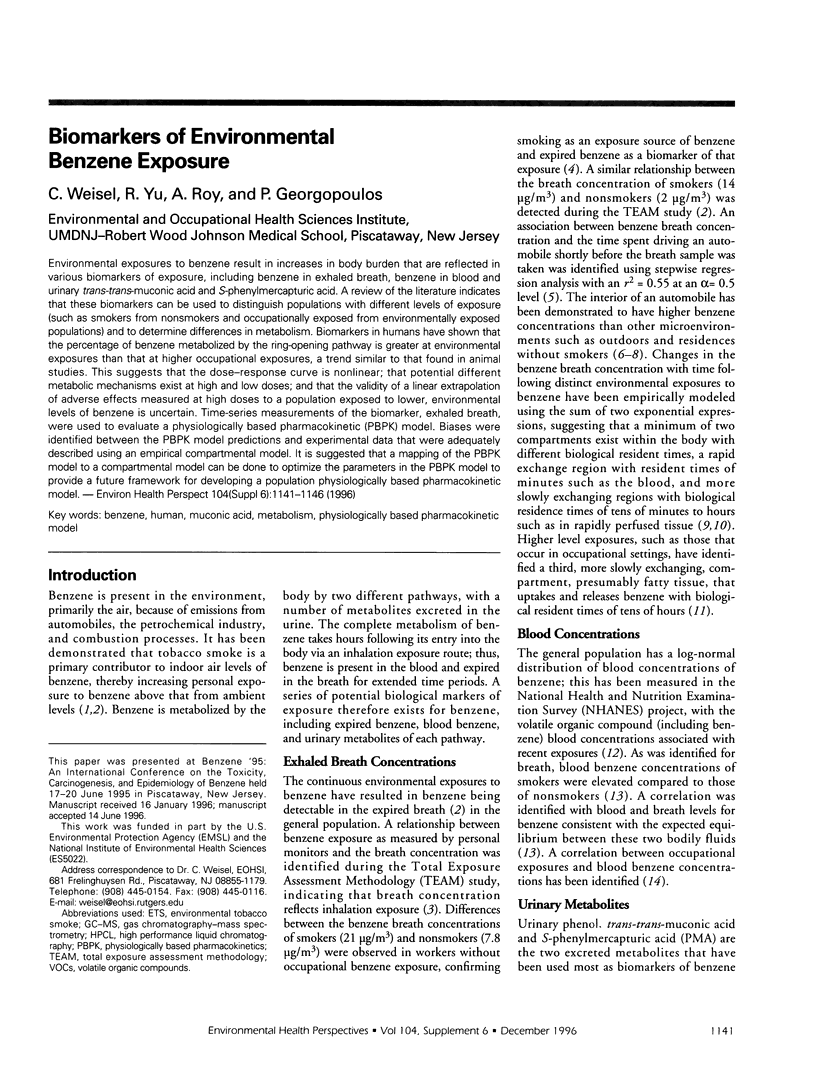
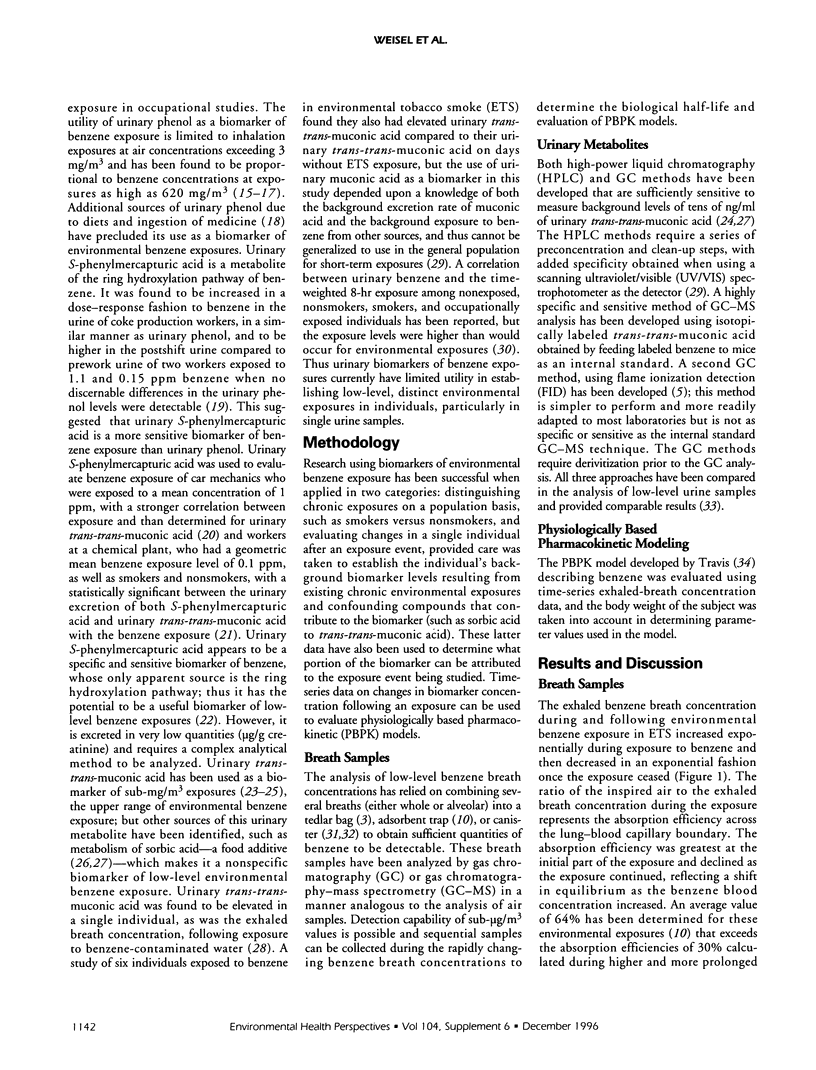

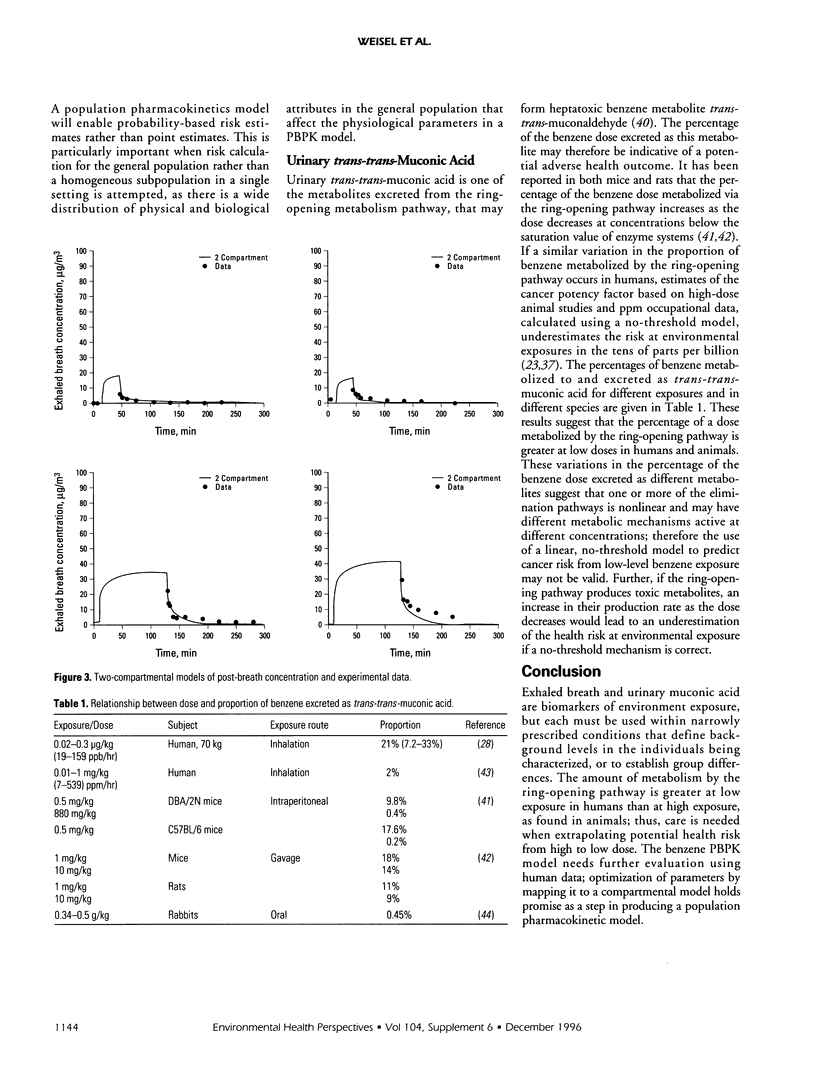
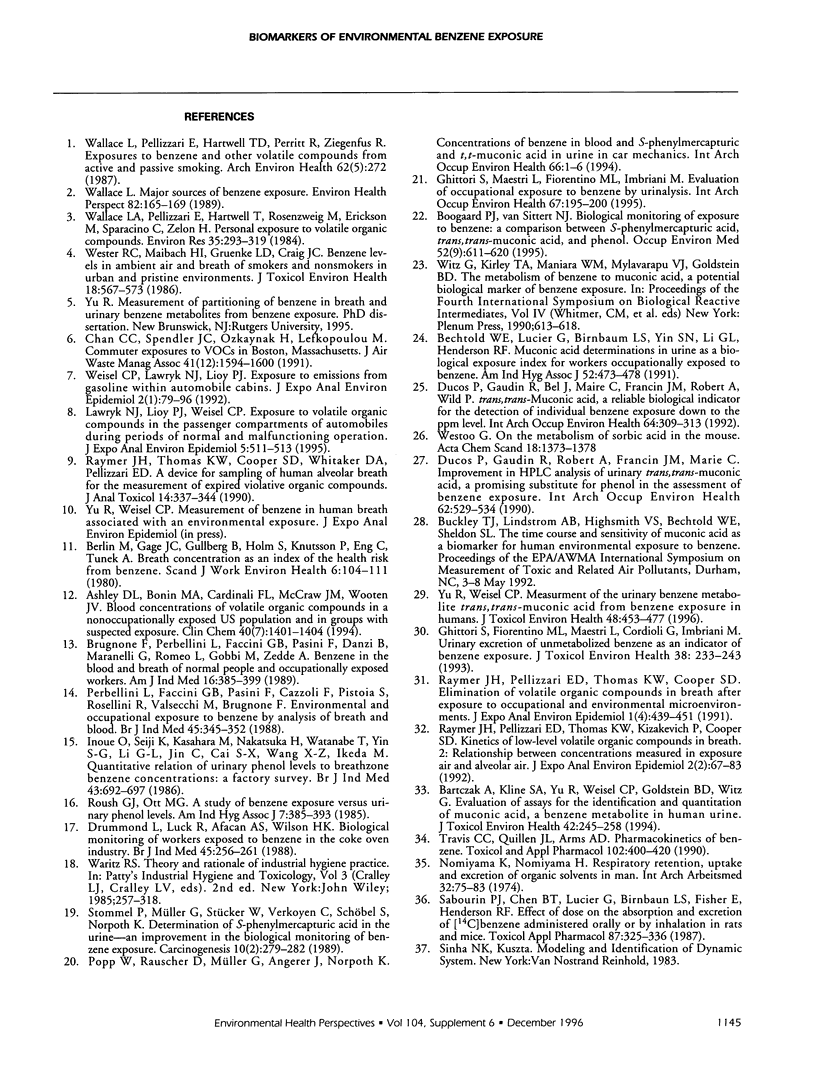
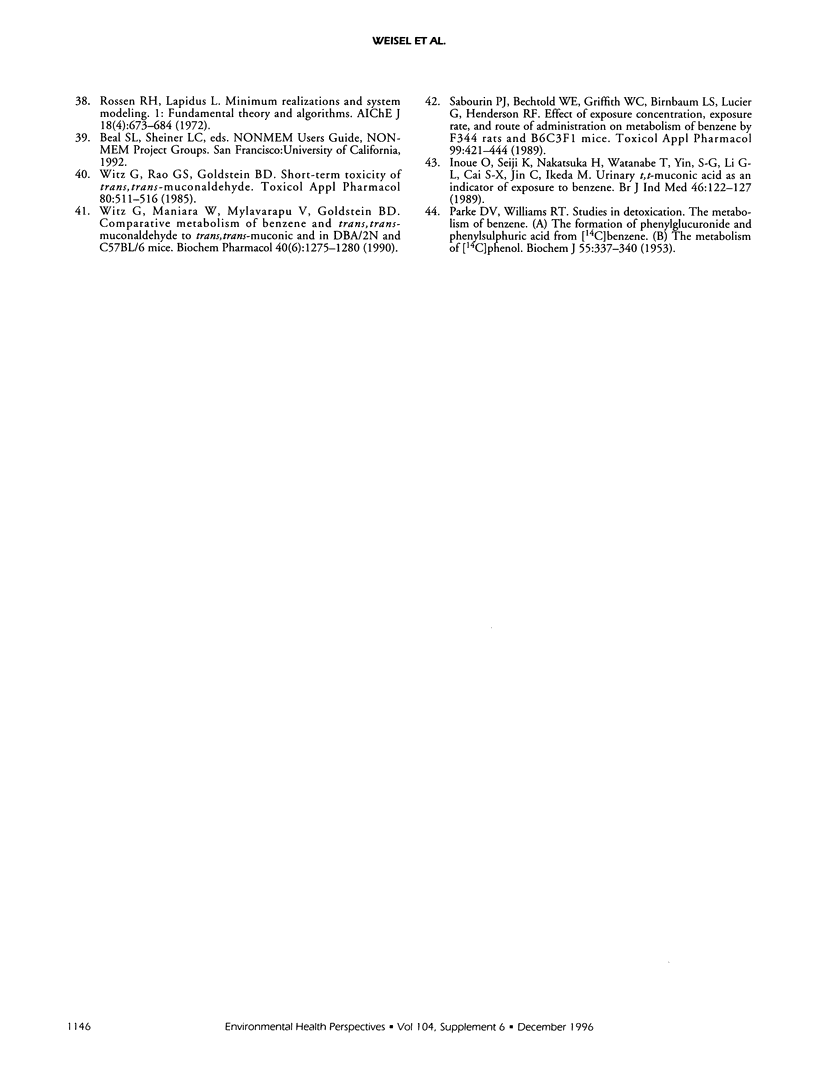
Selected References
These references are in PubMed. This may not be the complete list of references from this article.
- Ashley D. L., Bonin M. A., Cardinali F. L., McCraw J. M., Wooten J. V. Blood concentrations of volatile organic compounds in a nonoccupationally exposed US population and in groups with suspected exposure. Clin Chem. 1994 Jul;40(7 Pt 2):1401–1404. [PubMed] [Google Scholar]
- Bartczak A., Kline S. A., Yu R., Weisel C. P., Goldstein B. D., Witz G., Bechtold W. E. Evaluation of assays for the identification and quantitation of muconic acid, a benzene metabolite in human urine. J Toxicol Environ Health. 1994 Jul;42(3):245–258. doi: 10.1080/15287399409531877. [DOI] [PubMed] [Google Scholar]
- Bechtold W. E., Lucier G., Birnbaum L. S., Yin S. N., Li G. L., Henderson R. F. Muconic acid determinations in urine as a biological exposure index for workers occupationally exposed to benzene. Am Ind Hyg Assoc J. 1991 Nov;52(11):473–478. doi: 10.1080/15298669191365072. [DOI] [PubMed] [Google Scholar]
- Berlin M., Gage J. C., Gullberg B., Holm S., Knutsson P., Eng C., Tunek A. Breath concentration as an index of the health risk from benzene. Studies on the accumulation and clearance of inhaled benzene. Scand J Work Environ Health. 1980 Jun;6(2):104–111. doi: 10.5271/sjweh.2625. [DOI] [PubMed] [Google Scholar]
- Boogaard P. J., van Sittert N. J. Biological monitoring of exposure to benzene: a comparison between S-phenylmercapturic acid, trans,trans-muconic acid, and phenol. Occup Environ Med. 1995 Sep;52(9):611–620. doi: 10.1136/oem.52.9.611. [DOI] [PMC free article] [PubMed] [Google Scholar]
- Brugnone F., Perbellini L., Faccini G. B., Pasini F., Danzi B., Maranelli G., Romeo L., Gobbi M., Zedde A. Benzene in the blood and breath of normal people and occupationally exposed workers. Am J Ind Med. 1989;16(4):385–399. doi: 10.1002/ajim.4700160406. [DOI] [PubMed] [Google Scholar]
- Chan C. C., Spengler J. D., Ozkaynak H., Lefkopoulou M. Commuter exposures to VOCs in Boston, Massachusetts. J Air Waste Manage Assoc. 1991 Dec;41(12):1594–1600. doi: 10.1080/10473289.1991.10466955. [DOI] [PubMed] [Google Scholar]
- Drummond L., Luck R., Afacan A. S., Wilson H. K. Biological monitoring of workers exposed to benzene in the coke oven industry. Br J Ind Med. 1988 Apr;45(4):256–261. doi: 10.1136/oem.45.4.256. [DOI] [PMC free article] [PubMed] [Google Scholar]
- Ducos P., Gaudin R., Bel J., Maire C., Francin J. M., Robert A., Wild P. trans,trans-Muconic acid, a reliable biological indicator for the detection of individual benzene exposure down to the ppm level. Int Arch Occup Environ Health. 1992;64(5):309–313. doi: 10.1007/BF00379538. [DOI] [PubMed] [Google Scholar]
- Ducos P., Gaudin R., Robert A., Francin J. M., Maire C. Improvement in HPLC analysis of urinary trans,trans-muconic acid, a promising substitute for phenol in the assessment of benzene exposure. Int Arch Occup Environ Health. 1990;62(7):529–534. doi: 10.1007/BF00381185. [DOI] [PubMed] [Google Scholar]
- Ghittori S., Fiorentino M. L., Maestri L., Cordioli G., Imbriani M. Urinary excretion of unmetabolized benzene as an indicator of benzene exposure. J Toxicol Environ Health. 1993 Mar;38(3):233–243. doi: 10.1080/15287399309531715. [DOI] [PubMed] [Google Scholar]
- Ghittori S., Maestri L., Fiorentino M. L., Imbriani M. Evaluation of occupational exposure to benzene by urinalysis. Int Arch Occup Environ Health. 1995;67(3):195–200. doi: 10.1007/BF00626352. [DOI] [PubMed] [Google Scholar]
- Inoue O., Seiji K., Kasahara M., Nakatsuka H., Watanabe T., Yin S. G., Li G. L., Jin C., Cai S. X., Wang X. Z. Quantitative relation of urinary phenol levels to breathzone benzene concentrations: a factory survey. Br J Ind Med. 1986 Oct;43(10):692–697. doi: 10.1136/oem.43.10.692. [DOI] [PMC free article] [PubMed] [Google Scholar]
- Inoue O., Seiji K., Nakatsuka H., Watanabe T., Yin S. N., Li G. L., Cai S. X., Jin C., Ikeda M. Urinary t,t-muconic acid as an indicator of exposure to benzene. Br J Ind Med. 1989 Feb;46(2):122–127. doi: 10.1136/oem.46.2.122. [DOI] [PMC free article] [PubMed] [Google Scholar]
- Lawryk N. J., Lioy P. J., Weisel C. P. Exposure to volatile organic compounds in the passenger compartment of automobiles during periods of normal and malfunctioning operation. J Expo Anal Environ Epidemiol. 1995 Oct-Dec;5(4):511–531. [PubMed] [Google Scholar]
- Nomiyama K., Nomiyama H. Respiratory retention, uptake and excretion of organic solvents in man. Int Arch Arbeitsmed. 1974;32(1):75–83. doi: 10.1007/BF00539097. [DOI] [PubMed] [Google Scholar]
- PARKE D. V., WILLIAMS R. T. Studies in detoxication. 54. The metabolism of benzene. (a) The formation of phenylglucuronide and phenylsulphuric acid from [14C]benzene. (b) The metabolism of [14C]phenol. Biochem J. 1953 Sep;55(2):337–340. doi: 10.1042/bj0550337. [DOI] [PMC free article] [PubMed] [Google Scholar]
- Perbellini L., Faccini G. B., Pasini F., Cazzoli F., Pistoia S., Rosellini R., Valsecchi M., Brugnone F. Environmental and occupational exposure to benzene by analysis of breath and blood. Br J Ind Med. 1988 May;45(5):345–352. doi: 10.1136/oem.45.5.345. [DOI] [PMC free article] [PubMed] [Google Scholar]
- Popp W., Rauscher D., Müller G., Angerer J., Norpoth K. Concentrations of benzene in blood and S-phenylmercapturic and t,t-muconic acid in urine in car mechanics. Int Arch Occup Environ Health. 1994;66(1):1–6. doi: 10.1007/BF00386572. [DOI] [PubMed] [Google Scholar]
- Raymer J. H., Pellizzari E. D., Thomas K. W., Cooper S. D. Elimination of volatile organic compounds in breath after exposure to occupational and environmental microenvironments. J Expo Anal Environ Epidemiol. 1991 Oct;1(4):439–451. [PubMed] [Google Scholar]
- Raymer J. H., Thomas K. W., Cooper S. D., Whitaker D. A., Pellizzari E. D. A device for sampling of human alveolar breath for the measurement of expired volatile organic compounds. J Anal Toxicol. 1990 Nov-Dec;14(6):337–344. doi: 10.1093/jat/14.6.337. [DOI] [PubMed] [Google Scholar]
- Sabourin P. J., Bechtold W. E., Griffith W. C., Birnbaum L. S., Lucier G., Henderson R. F. Effect of exposure concentration, exposure rate, and route of administration on metabolism of benzene by F344 rats and B6C3F1 mice. Toxicol Appl Pharmacol. 1989 Jul;99(3):421–444. doi: 10.1016/0041-008x(89)90151-8. [DOI] [PubMed] [Google Scholar]
- Sabourin P. J., Chen B. T., Lucier G., Birnbaum L. S., Fisher E., Henderson R. F. Effect of dose on the absorption and excretion of [14C]benzene administered orally or by inhalation in rats and mice. Toxicol Appl Pharmacol. 1987 Feb;87(2):325–336. doi: 10.1016/0041-008x(87)90294-8. [DOI] [PubMed] [Google Scholar]
- Stommel P., Müller G., Stücker W., Verkoyen C., Schöbel S., Norpoth K. Determination of S-phenylmercapturic acid in the urine--an improvement in the biological monitoring of benzene exposure. Carcinogenesis. 1989 Feb;10(2):279–282. doi: 10.1093/carcin/10.2.279. [DOI] [PubMed] [Google Scholar]
- Travis C. C., Quillen J. L., Arms A. D. Pharmacokinetics of benzene. Toxicol Appl Pharmacol. 1990 Mar 1;102(3):400–420. doi: 10.1016/0041-008x(90)90037-u. [DOI] [PubMed] [Google Scholar]
- Wallace L. A. Major sources of benzene exposure. Environ Health Perspect. 1989 Jul;82:165–169. doi: 10.1289/ehp.8982165. [DOI] [PMC free article] [PubMed] [Google Scholar]
- Wallace L. A., Pellizzari E., Hartwell T., Rosenzweig M., Erickson M., Sparacino C., Zelon H. Personal exposure to volatile organic compounds. I. Direct measurements in breathing-zone air, drinking water, food, and exhaled breath. Environ Res. 1984 Oct;35(1):293–319. doi: 10.1016/0013-9351(84)90137-3. [DOI] [PubMed] [Google Scholar]
- Wallace L., Pellizzari E., Hartwell T. D., Perritt R., Ziegenfus R. Exposures to benzene and other volatile compounds from active and passive smoking. Arch Environ Health. 1987 Sep-Oct;42(5):272–279. doi: 10.1080/00039896.1987.9935820. [DOI] [PubMed] [Google Scholar]
- Weisel C. P., Lawryk N. J., Lioy P. J. Exposure to emissions from gasoline within automobile cabins. J Expo Anal Environ Epidemiol. 1992 Jan-Mar;2(1):79–96. [PubMed] [Google Scholar]
- Wester R. C., Maibach H. I., Gruenke L. D., Craig J. C. Benzene levels in ambient air and breath of smokers and nonsmokers in urban and pristine environments. J Toxicol Environ Health. 1986;18(4):567–573. doi: 10.1080/15287398609530894. [DOI] [PubMed] [Google Scholar]
- Witz G., Maniara W., Mylavarapu V., Goldstein B. D. Comparative metabolism of benzene and trans,trans-muconaldehyde to trans,trans-muconic acid in DBA/2N and C57BL/6 mice. Biochem Pharmacol. 1990 Sep 15;40(6):1275–1280. doi: 10.1016/0006-2952(90)90393-y. [DOI] [PubMed] [Google Scholar]
- Witz G., Rao G. S., Goldstein B. D. Short-term toxicity of trans,trans-muconaldehyde. Toxicol Appl Pharmacol. 1985 Sep 30;80(3):511–516. doi: 10.1016/0041-008x(85)90396-5. [DOI] [PubMed] [Google Scholar]
- Yu R., Weisel C. P. Measurement of the urinary benzene metabolite trans,trans-muconic acid from benzene exposure in humans. J Toxicol Environ Health. 1996 Aug 9;48(5):453–477. doi: 10.1080/009841096161186. [DOI] [PubMed] [Google Scholar]


